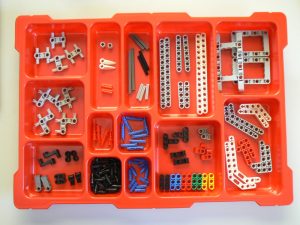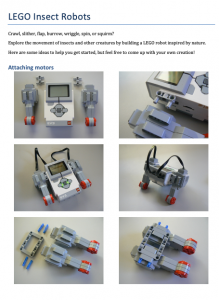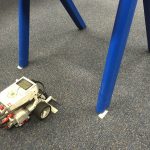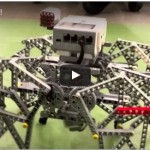This classic introductory robotics challenge requires little, if any, formal teaching. In addition to being a lot of fun, it provides a great way of assessing prior experience. At the very least, it allows you to check that everyone knows how to make their robot move.
The challenge
Make a robot that moves in the silliest way possible.
43 phenotypes
I often lead into this challenge by presenting the following video clip and point out that even though each model is built from the same, relatively small, set of building elements, notice how much variety there is in the different kinds of movement generated. Of course, some are more successful at moving than others. (-:
Note: I would love to see an updated version of this video (i.e. EV3-based, hi-res, with a parts list and possibly some building instructions). A great student project, perhaps? Please contact us if you or one of your students is interested.
Teacher notes
If there’s time available, this can also be a great way to introduce the EV3 software in an exploratory way for first time users, e.g. “Here’s the software. Can you work out how to make a motor move?”
If time is short, or you don’t have access to the EV3 software (sometimes I’ve still been waiting for the software to be installed during the first week of the school year), then this could be framed as a building only challenge by downloading the following project onto all the EV3 bricks ahead of time.
- Download: Silly walks.ev3
This project contains four simple programs to run one or two motors, in either a forward or reverse direction.

Incidentally, I used to present this challenge as a “No Wheels” challenge, i.e make a robot that moves, without using wheels as wheels, but I’ve found that framing it in terms of moving in the silliest way possible promotes more creativity and experimentation. “Yes, you can use wheels, but it’s not very silly is it?”
When I give this challenge to my class as an introductory activity, I often provide each team of two or three students with the full EV3 Core Set (45544), but I’ve also found that it works well to give them a restricted set of parts. For example, in a workshop that focused on insect-inspired movement, I provided the following set of parts…

Download: LEGO Insect Robots (PDF, 4MB) – This contains ideas for building a LEGO robot inspired by nature.

Useful links…
- Artificial Intelligence: Exploring Movement – This is the original NXT-based post containing the 43 phenotypes video clip.
- DIY Walkers – This series contains some great ideas if you want to delve deeper into walking mechanisms.
- Ian Chow-Miller talks more about this challenge, framed as “Move Without Wheels”, and provides lots of example of his students work…
Rob Torok
Latest posts by Rob Torok (see all)
- Obstacle Course - 26 August 2020
- Crash Test Dummy - 26 August 2020
- The Wave - 21 May 2020
- Build X - 20 May 2020
- Build a Duck - 20 May 2020


